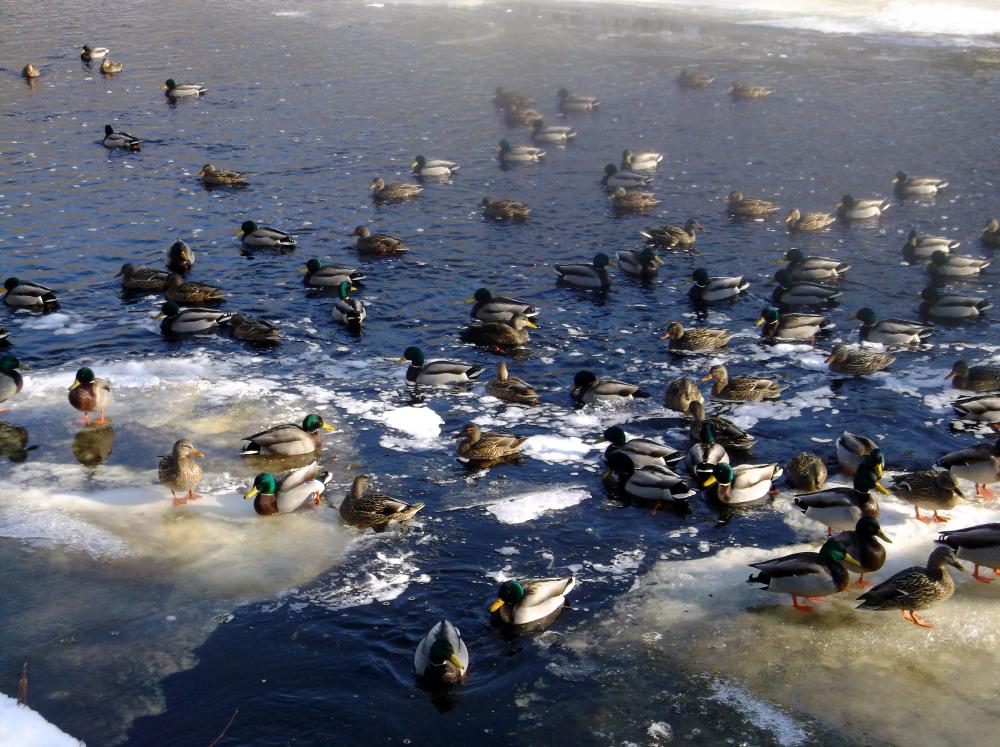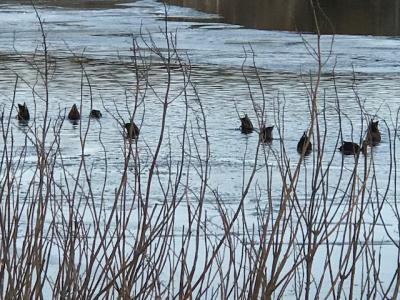Blizzard and Arctic Chill Both Factors in Lloyd Center February Waterfowl Survey
Mar 2, 2022
To close out the 35th annual winter waterfowl survey, Lloyd Center staff and volunteers ventured out in single digit temperatures on Sunday, February 6, to survey the estuaries and coastal ponds, from Sakonnet Point in RI, to Padanaram Harbor in MA. High ice coverage and tides made for conditions highly comparable to a year ago, the difference being remnant snow cover from a blizzard that postponed this count by one week.
The count total of 10,165 waterfowl was the highest observed since 2003, with the overall total between the two counts of 14,751 the highest observed since the 2003/2004 season. This is due to the high count of Canada Geese which totaled 5,925 for this survey and 6,762 for the season and followed the same trend. We know the local Canada Goose population has skyrocketed and migrants add to the total during fall and winter, but why the huge spike over a one-year timeframe for the winter survey? Combined factors of the cold trend causing ice in freshwater, and remnant snow from the blizzard covering nearby fields, were both factors. Snowy fields were likely the biggest factor, sending birds to the shorelines, particularly estuaries, to feed on aquatic vegetation or wait it out. As expected, goose numbers were high in the Westport River, but distributed across different sections of this huge estuary. Geese packed into other large estuaries including the Slocum River (1,215) and Apponagansett Bay (840) in Dartmouth, and into even smaller Rhode Island sites including Fogland Marsh (900) and Sapowet Wildlife Refuge (850).
As expected, the common dabblers, Black Ducks and Mallards, increased in flowing estuaries due to the ice coverage. Black ducks are more directly dependent upon shallow estuaries than any duck species, and thus had high abundance in their usual peak sites of the Westport River, the Slocum River, Allens Pond, and Little River, with ice likely bringing more birds down from northern boreal regions. Mallards were abundant on the Westport River, Apponagansett Bay, Nannaquaket Pond, and the Slocums River, and likely consisted more of local birds usually found in local freshwater ponds.
For divers, species associated with estuaries were less impacted than those more specific to coastal ponds. Common estuarine divers including red-breasted merganser and bufflehead showed only subtle increases, while common goldeneye increased slightly more. Goldeneye and bufflehead were abundant in both the Westport and Slocum Rivers, with bufflehead also, as usual, abundant on Apponagansett Bay, which offers a mix of vast open bay and shallow creeks. Red-breasted mergansers had a sizeable flock in Cockeast Pond and were otherwise distributed in small numbers across various systems.
Two other divers with notable increases were scaup, which prefer vast open water and were highly abundant in Apponagansett Bay, and Hooded Mergansers, which target shallow estuaries but had a large flock in Cockeast Pond. A large flock of Ring-necked Ducks (175) was seen in Round Pond which accounted for most sightings for this species, which is almost exclusive to ponds. This tight flocking behavior was also indicative of the ice conditions, as was the slight decline in the species overall from a year ago.
Two rarities included Snow Geese on the Westport River, the species prevalent in fields this year due to more snow cover, and Common Mergansers on both the Westport River and Cockeast Pond. Unlike the Red-breasted Merganser which prefers coastal waters, the Common Merganser is usually found in freshwater lakes or ponds and is also a good indicator of the cold trends that impacted waterfowl numbers this January.













